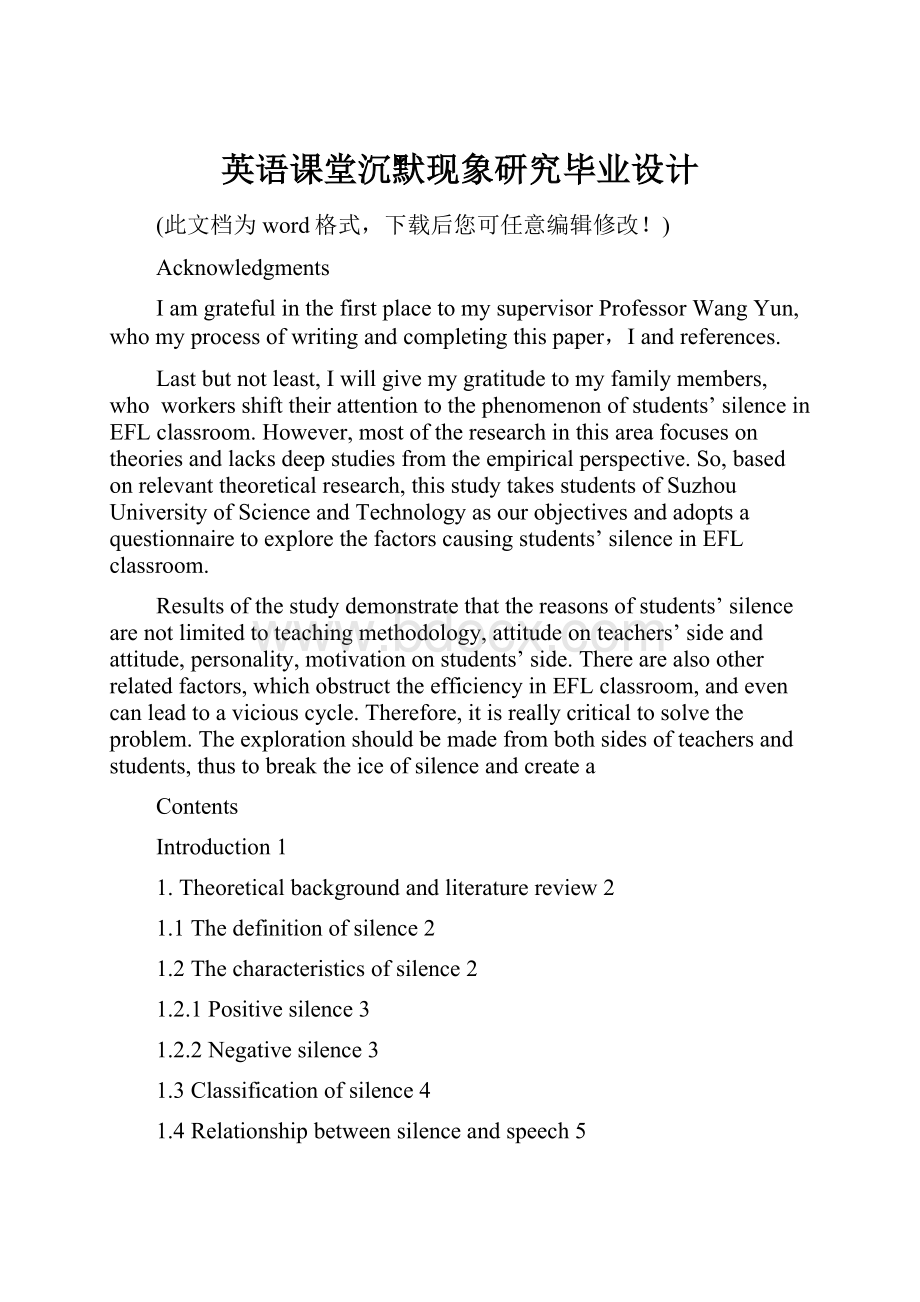英语课堂沉默现象研究毕业设计.docx
《英语课堂沉默现象研究毕业设计.docx》由会员分享,可在线阅读,更多相关《英语课堂沉默现象研究毕业设计.docx(19页珍藏版)》请在冰豆网上搜索。

英语课堂沉默现象研究毕业设计
(此文档为word格式,下载后您可任意编辑修改!
)
Acknowledgments
IamgratefulinthefirstplacetomysupervisorProfessorWangYun,whomyprocessofwritingandcompletingthispaper,Iandreferences.
Lastbutnotleast,Iwillgivemygratitudetomyfamilymembers,whoworkersshifttheirattentiontothephenomenonofstudents’silenceinEFLclassroom.However,mostoftheresearchinthisareafocusesontheoriesandlacksdeepstudiesfromtheempiricalperspective.So,basedonrelevanttheoreticalresearch,thisstudytakesstudentsofSuzhouUniversityofScienceandTechnologyasourobjectivesandadoptsaquestionnairetoexplorethefactorscausingstudents’silenceinEFLclassroom.
Resultsofthestudydemonstratethatthereasonsofstudents’silencearenotlimitedtoteachingmethodology,attitudeonteachers’sideandattitude,personality,motivationonstudents’side.Therearealsootherrelatedfactors,whichobstructtheefficiencyinEFLclassroom,andevencanleadtoaviciouscycle.Therefore,itisreallycriticaltosolvetheproblem.Theexplorationshouldbemadefrombothsidesofteachersandstudents,thustobreaktheiceofsilenceandcreatea
Contents
Introduction1
1.Theoreticalbackgroundandliteraturereview2
1.1Thedefinitionofsilence2
1.2Thecharacteristicsofsilence2
1.2.1Positivesilence3
1.2.2Negativesilence3
1.3Classificationofsilence4
1.4Relationshipbetweensilenceandspeech5
1.5Thecurrentsituationofsilencestudyatempiricalstudyofstudents’silenceinEFLclassroom8
2.1Researchquestions8
2.2Researchmethodology9
2.2.1Researchsubjects9
2.2.2Researchmaterials9
2.2.3Researchprocedure9
2.3Datacollectionandanalysis10
2.3.1Datacollection10
2.3.2Dataanalysis10
2.4Thefindings11
2.4.1Teachers’aspects11
2.4.2Students’aspects12
2.4.3Otheraspects12
3.Someimplicationsandsuggestionsforstudentsandteachers13
3.1Forstudents13
3.2Forteachers14
Conclusion15
References17
Appendix1:
19
Appendix2:
21
Students’SilenceinEFLClassroom
Introduction
Inrecentyears,thephenomenonofstudents’silence.Mostofthem,suchasteachers’talkinELFclass,teachers’questioningmethods,etc,butfewresearches.
DuetothenewrequirementsofCollegeEnglishRequirements(2007:
25),thepedagogicaltendencyinEFLclassemphasizesonstudents’rolesandaimstocreateastudent-centeredteachingenvironment.Thus,manyteachers.Itprovidesstudentswithmoreopportunitiesbutalsomuchpressure.Studentsmayemploysilenceastheformofcommunicativeengagementandonlyasmallproportionofstudentsactivelyparticipateinclass.Ontheotheroreventheenemyofspeechandfewteacherspropermeasurestoresolvetheproblem.ThemisunderstandingorincompleteunderstandingofsilencemayleadtoaviciouscircleinELFclass.
Meyer(Kevin2009:
16)putforwardtheconceptionofHypothesizedLinkbetweenSilenceandLearning.Furthermore,shedefinedsilentengagementasakindofcommunication.Onthistheoreticalbasis,moreandmoreresearchersdiverttheirattentiontothevalueofsilenceandexploretherelationshipbetweenspeechandsilenceinELFclass.Thecausesofstudents’silenceinELFclassaremultidimensionalduetodifferentresearchanglesandpurpose.
Infact,silenceitsownrightcanbeseentomakeapositivecontributiontothescopeofthemeaningful”(1980:
104)Silencepavesthewayforthepotencyoflanguagesincesilencegivesbothbirthandconclusiontospeech.
Thisthesiswillbedoneonthebasisofthepreviousstudiesrelatedtothephilosophyofspeechandsilence,factorsinfluencingstudentparticipationandlearningstyles.InordertomaketheresearchbeputintopracticeandfutureteachinginELFclass.
1.Theoreticalbackgroundandliteraturereview
Silenceisameansofpowerfulnonverbalcommunication,themostproperway,variousconnectedaspectsshouldbeconsidered,includingsubjectiveandobjectivefactors.Thesubjectivefactorsincludethefeelings,personality,mutualrelationsandthedegreeofcaring,whiletheobjectivefactorsarelocation,time,culturebackgroundetc.Todigouttherootcausesofstudents’silenceinEFLclass,closeattentionshouldfirstbepaidonthedefinitionofsilence.
1.1Thedefinitionofsilence
Accordingtodifferentpurposeswithvariousresearchframeworks,thedefinitionofsilencedistinguishesfromoneandanother.
OxfordAdvancedLearner’sEnglish-ChineseDictionary(Hornsby2009:
1408)definessilenceasthefollowingmeanings:
(1)completeabsenceofsoundornoise;quiet;
(2)refusalorfailuretodiscusssomethingoranswerquestionsaboutsomething;(3)completequietbecausenobodyistalking;(4)aperiodoftimeinwhicheveryonestopstalkingasasignofrespectandtoexplainthepropermeaningofsilence.
InEncyclopedicDictionaryofAppliedLinguistics:
AHandbookforLanguagecaseofspeech,rule-governed,anditisalsovariableandculturalspecific.
Tothreeforms:
Psycholinguisticsilence;InteractivesilenceandSocio-culturalsilence.Consideringthecommunicationfunctions,everytype.
Asthispaperaimstostudystudents’silenceinEFLclassroom,thedefinitionoftheinteractivesilenceswillbethecorepart.Interactivesilenceisthepausalinterruptionindialogue,conversation,discussion,debate,etc.Theycanberelatedtoaffective,interpersonalrelationshipsbetweenpeopleaswellastotheexchangeofinformationandorproblemsolving(Bruneau1973:
29).
1.2Thecharacteristicsofsilence
Iftheambiguousaspectsofsilencemaybeconcludedclearly,furtherstudiesinthisareacanbemademoresmoothly.Inlow-contextculture,silenceisnegativeforthemostpart,anditisconsideredasalackofcommunication.Jensenrevelation,linkage,activatingandjudgmental.Basically,silencecanbedividedintotwoparts:
positivesilenceandnegativesilence.
1.2.1Positivesilence
Silencecanaffectpeople.Insomeembarrassingsituation,silenceofferpeoplesometimeforreflectionandbuffering.Nonverballanguagecanexpressthedeepestfearsandmostintensejoys.Silencecanbeunderstoodasrespect,acceptanceorkindnessinchurchorlibrary.Tosumup,silence,tosomedegrees,isthelanguageofthosestrongpassions:
love,anger,surpriseorfear.Silenceisacommonstrategytomanagetensesituations,especiallyforfunction.Itmayimpartsomeinformationwhilepreventingthedisclosureofother(Jensen1973:
120).Wecanfindclearimplicationinsomesituations.Forexample,silencecanworkastheconveyorofmessageinclass,whenstudentsthinkabouttheanswerstoquestions,theteacheroftenchoosetobesilent.Althoughtheoveralllanguageenvironmentissilent,students’mindskeepgoingon.Wecancallitrevelationsilenceinthiscase.
Insomecases,akindofsilenceiscalled“linkagesilence”.Inthesocialculture,silencecanactasabondamongpeople.Thiskindofsilenceispositiveasisusedtomaintainsocialspaceorpreventinterruption.Suchasthesituationthattwostrangersinelevatorsorcrowdedbusesusuallykeepsilent.Thiscouldalsoamongintimatefriends.Theykeepsilentbecausetheyunderstandeachothersowellandthereisnoneedputtingthoughtsintowords.
Silencecanleadtoanassumptionofassentandagreementwithwhatsaid.Theoldsayings“silenceisconsent”expressessuchmeaning.Tosomedegrees,silencecangiveussomerepresentsomenegativefeelings,suchas,orevenrepresentdishonestyandlying.Weallknowatcourt,thejuryandlawyer’sinterpretationofthenegativeiftheykeepsilent.
Silencecancommunicateanattitudeofthoughtfulnessandconsiderationoranabsenceofthoughtoropinion(Jensen1973:
123).SilenceactivatingfunctioninEFLclassroom.Intraditionalteachingpattern,theteacherplaystheroleasthecenterofclassanddominatestheteachingprocedure,whilethestudentsaresilentlistenersorreaderslackingoftheirownthoughts.WiththepromotionofnewCollegeEnglishCurriculumRequirements,modernclassroomsrequirestudentstoplaythemajorroles.Interactiveclassshouldbeteachers’silencemorethanthoseofstudents.Teachersshouldchangetheirauthoritativerolesandcreatestudents-centeredclassroomsettings.
Silencecanalsobeinterpretedasdisagreementandresentment(Jensen1973:
121).Besidesthis,silencealsostandsfordissent,orreservationandpotentialaction.Itwill.
Accordingtowhatbeconcludedthat“silencecanperformanumberof1973).However,theexactlymeaningofsilenceshouldbeembeddedinthecontext.Inotherwords,silencefunctionseitherpositivelyornegatively,whichshoulddependontheconcretecontext.What’smore,positivesilencecantransferintonegativesilenceinEFLclassiftheteachersfailuretostimulatethestudentsincorrectdirection.
1.3Classificationofsilence
(1)Bruneau’sclassificationofsilence.
Silenceistospeechasthewhiteofthispapertothisprint(Bruneau1973:
18).Tosilence,Bruneausummarizesthreeformsofsilenceasfollowing:
(a)Interactivesilences.
Interactivesilenceistheinterruptionindialogue,conversation,discussion,debate,etc.Theycanberelatedtoaffective,interpersonalrelationshipsbetweenpeopleaswellastotheexchangeofinformationandorproblemsolving(Bruneau1973:
29).Comparedwithpsycholinguistic,slow-timesilences,interactivesilencesarelonger.Peoplecaninteractivesilences.Inclasscontext,thetypicalexamplesofinteractivesilencesareinteractionsbetweenteachersandstudents.Afterputtingforwardaquestion,teachersmaykeepsilencewhilestudentsarethinkingaboutthegivenquestions.Whenteachersareteachingtheoreticalknowledge,studentskeepsilent